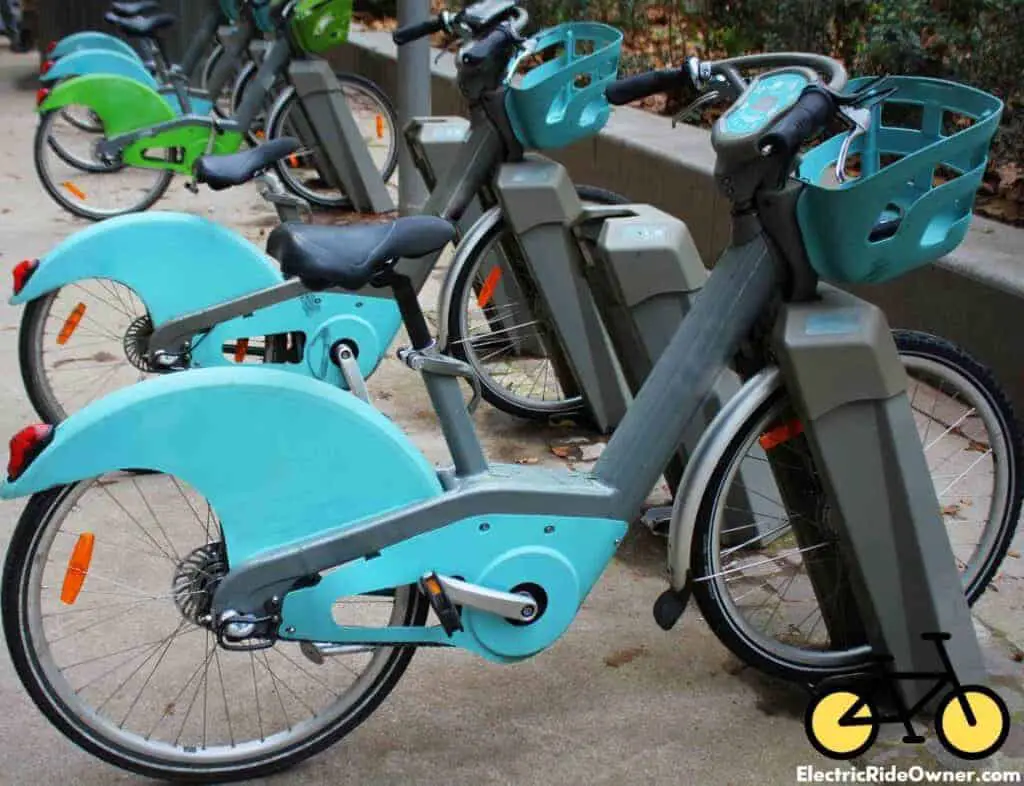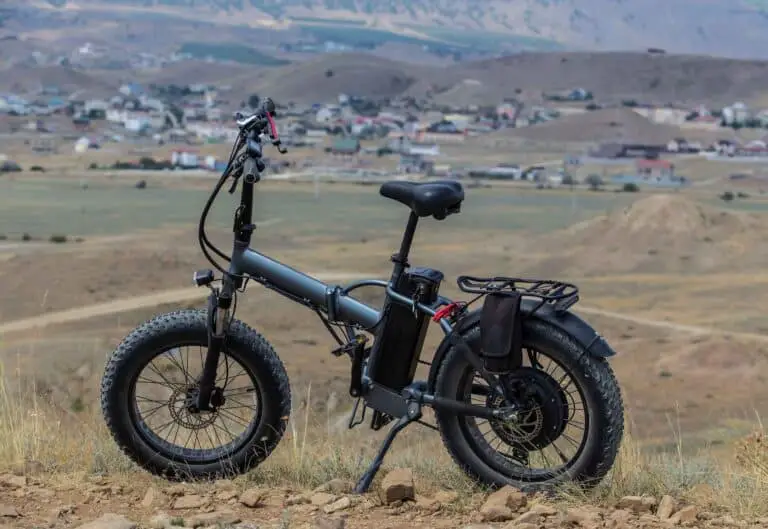Giant Vs. Scott Vs. Cube Vs. KTM Vs. Haibike eBike (Clear Winner)
When I initially decided to buy an eBike, I was trying to pick between Giant, Scott, Cube, KTM, and a Haibike eBike. I had to do a lot of research to determine which eBike would suit my needs. I made many lists and charts comparing my top five choices, weighing factors like brand, weight, cost, reliability, and range. I have compiled and organized my findings to share with others who, like me, are not sure which electric bike is the clear winner.
In total, of all the models of electric bikes offered by these five brands, I believe the KTM Macina Sport 720 is the clear winner. Priced at only $4,808 and equipped with a Bosch Power Tube 750 Wh battery, this bike is great for both urban and trail riding and is the best bang for your buck.
On average, users report the best experience with Haibike eBikes. Haibike only manufactures electric bikes, so its brand revolves around creating the best quality and most efficient electric bikes for its users.
In general, the best type of electric bike to buy as a beginner is a touring or trekking e-bike. Each brand on this list, with the exception of Haibike, makes a touring e-bike. These eBikes are a great purchase because they can be ridden on any terrain and tend to be in the mid-to-lower cost range.
Is the Giant motor better than the Bosch motors equipped on the four other bikes on this list? Is one of these choices clearly better than the others? In my research compiled below, I have compared the cost of purchases, ride types available, running costs, lifespan, range tests, weight, and reliability of Giant, Scott, Cube, KTM, and Haibikes.
| Giant eBike | Scott eBike | Cube eBike | KTM eBike | Haibike eBike | |
| Cost of Purchase | $2,600- $9,300 | $3,499-$9,999 | $2,699-$9,449 | $4,410-$7,575 | $3,225-$6,800 |
| Ride Types Available | Road/Trail/Trekking/Enduro | Road/Mountain/All Terrain/Enduro/City | Road/Touring-Hybrid/Mountain/City | Road/Trekking OffRoad/Hybrid/Moutain/City | Mountain/Trekking |
| Running Cost | To charge, $0.14 USD/kWh (cost varies by state). | To charge, $0.14 USD/kWh (cost varies by state). | To charge, $0.14 USD/kWh (cost varies by state). | To charge, $0.14 USD/kWh (cost varies by state). | To charge, $0.14 USD/kWh (cost varies by state). |
| Lifespan | 3-5 years before needing to replace parts | 3-5 years before needing to replace parts | 3-5 years before needing to replace parts | 3-5 years before needing to replace parts | 3-5 years before needing to replace parts |
| Cost of Maintenance | Avg. annual tune-up $150 | Avg. annual tune-up $150 | Avg. annual tune-up $150 | Avg. annual tune-up $150 | Avg. annual tune-up $150 |
| Travel Distance | Extreme: 25-37 miGood: 50-74 miIdeal: 90-118 mi Source | 25mi-90mi Depending on weight and ride conditions(According to Bosch eBike motor calculator) | 25mi-90mi Depending on weight and ride conditions(According to Bosch eBike motor calculator) | 25mi-90mi Depending on weight and ride conditions(According to Bosch eBike motor calculator) | 25mi-90mi Depending on weight and ride conditions(According to Bosch eBike motor calculator) |
| Reliability | Reliable when properly maintained | Reliable when properly maintained | Reliable when properly maintained | Reliable when properly maintained | Reliable when properly maintained |
| Weight | Avg. 55lbs | 24lbs-61lbs | 50-60lbs | 55lbs-60lbs | Avg. 50lbs |
| Tire Size | 27-29 | 26-28 | Avg. 27 | 23-28 | 26-29 |
Cost of Giant Vs. Scott Vs. Cube Vs. KTM Vs. Haibike eBikes
On average, Haibike offers the lowest priced eBike of those on this list. The Giant Roam E+ is the cheapest eBike on this list, at $2,600. The most expensive eBike listed is the Scott Addict eRIDE Ultimate electric bike, at $9,999. This difference is mostly due to the e-bike’s frame material.
E-bikes, no matter the cost, will be a hefty investment. Before purchasing your eBike, you will want to make sure you do thorough research on which e-bike will best suit your preferences. If you want an electric bike to replace a car for your commute to work in an urban area, the best electric bike for you will probably be a city electric bike, not a mountain electric bike.
Aluminum Frame Vs. Carbon Frame
On average, Haibike manufactures the lowest-priced e-bikes of the five brands mentioned on this list. The main reason Haibike’s e-bikes are less expensive is that their electric bike frames are made out of aluminum. Aluminum is known to be the least expensive material out of which a bike frame can be made. Electric bikes made of aluminum, especially electric mountain bikes, tend to feel stiffer and kick up far more dirt and debris during a trail ride than their carbon counterparts.
Electric bike frames made of carbon, like Scott e-bikes, offer an effect called “dampening” when ridden on trails. When an e-bike frame, or a standard bike frame for that matter, is made of carbon, the carbon “dampens,” or lessens, the roughness of loose terrain and absorbs some of the rumbles of a trail ride.
Thus, Scott electric bikes tend to be more expensive because the bike frames are made of carbon. Not only does carbon offer a dampening effect when you take your e-bike out on a trail, but it is also known to be more flexible and perhaps more resistant to damage from loose debris than aluminum.
It is also important to note that carbon can be repaired but aluminum cannot, so your return on investment for an electric bike with a carbon frame will be higher than your ROI on an electric bike with an aluminum frame.
You will also need to consider the fact that the initial cost of your electric bike is not the only money you will spend on your e-bike. Like other bikes, e-bikes require annual tune-ups.
After owning your electric bike for about three years you will probably have to replace its battery no matter the brand you choose. After you replace your electric bike battery once, you will typically have to replace it one or two more times throughout the 10-year average lifespan of your electric bike.
If you would like to learn more about the cost of your electric bike battery, check out our article on “How Long an Electric Bike Battery Last [Lifespan, Per Charge].”
Ride Types Available for Giant Vs. Scott Vs. Cube Vs. KTM Vs. Haibike eBikes
On average, Scott and KTM have the most variety of electric bike ride types available, including but not limited to e-bikes suited for mountain and city terrains. Haibike has the least variety of electric bikes available, with just mountain and trekking e-bikes.

In general, all-terrain, trekking, or touring electric bikes are the best ride type for you if you do a mix of urban and trail cycling. These electric bikes are available from each of the brands listed and typically cost about $3,000-$4,000, depending on the brand.
If you specifically want an electric bike for commuting, a city electric bike is probably your best choice. City e-bikes tend to be less expensive because they do not have the expensive, heavy-duty parts made for withstanding rough or uneven terrain. We recommend the Cube Ella Ride Hybrid for electric bike riding in an urban environment. Equipped with an ultralight aluminum frame and a Bosch motor, this bike is perfect for commuters.
Mountain and road eBikes tend to be the most expensive choice because of the durability of their parts. Mountain electric bikes have extremely durable components that make them safe to ride on rough trails. We recommend an electric mountain bike with a carbon frame, like the Scott Patron eRide 900 Tuned Bike, as carbon frames are better than their aluminum or alloy counterparts for off-road or trail riding.
Road e-bikes may have a larger battery capacity due to the high speeds many road cyclers prefer to ride. We recommend the Giant Fastroad E+ EX Pro for riding your e-bike on the road, as it has a large battery capacity (90 miles on a single charge!) and its aluminum frame keeps your costs low while still providing all the key features you will want for an efficient road ride.
“Melancholy is incompatible with bicycling.”
-James E. Starrs
Running Cost of Giant Vs. Scott Vs. Cube Vs. KTM Vs. Haibike eBikes
In general, the running cost of an electric will be roughly the same despite the brand. The running cost of an electric bike will depend on its battery capacity, as you will be paying for electricity to power the motor. The cost of electricity may vary by state, but the average is about $0.14/kWh. (Source).
Most electric bike batteries do not hold one whole kilowatt-hour, so the cost per charge will likely be less than the average $0.14/kWh, and will instead be roughly $.08 for a full charge.
A full charge on an electric bike battery will take you somewhere between 20-90mi, depending on your ride conditions and how often you use your motor.
Apart from the initial purchase cost, using an electric bike can be very inexpensive. While you may cover less distance in one charge than you might on say, a full tank of gas in a gas-powered bike or a car, the cost of several charges of your electric bike battery will still be less expensive when compared to the cost per mile of a comparable method of transportation.

Lifespan of Giant Vs. Scott Vs. Cube Vs. KTM Vs. Haibike eBikes
In total, electric bikes can last about three to five years before you need to replace any parts and ten years altogether. Generally, an e-bike will last about 10 years or 10,000 miles. Most electric bike batteries need to be replaced after three years, no matter how well you maintain your e-bike.
The key to optimizing your electric bike’s lifespan is maintaining it well. You can do this by:
- Cleaning your eBike after each use (especially the chain and frame)
- Storing your e-bike in a dry, mild environment
- Taking your electric bike for annual tune-ups
- Detaching your battery to charge it
- Not letting your battery die
- Not charging your battery all the way to 100%
- Not leaving your battery to charge overnight
If would like to learn more about how long an electric bike lasts, check out our article on How Long Does An Electric Bike Last (An Expert Weighs In).
Keeping your Electric Bike Clean to Extend Its Lifespan
If you consistently ride on loose terrain, you may need to clean your electric bike more often than someone who mostly rides on paved roads or trails. It is important to not let dirt cake on your e-bike frame or chains, because it may eventually damage a larger, more fundamental component of your electric bike, like the motor.
Another key component in keeping your electric bike clean to extend its lifespan is storing it in a clean and dry environment with a mild temperature. If you store your electric bike in your garage where you also practice your wood-working hobby, your e-bike may be subjected to dirt and debris, like sawdust, which can be detrimental if it contaminates a key component of your e-bike like the motor.
To clean your e-bike motor and your entire e-bike, we recommend using the Muck-off Bike Wash, which can be found on Amazon.
If you are interested in learning about the best storage solution for your e-bike, check out our article on 17 Electric Bike Storage Ideas You Can Actually Use (Home, Garage, Outside).
Electric Bike Battery Maintenance to Extend Its Lifespan
An electric bike battery generally needs to be replaced after three to five years, depending on how well you maintain it. To extend your battery’s lifespan, experts recommend not letting it die and not charging it to 100% each time you charge it, or at least not keeping it plugged in once it reaches 100%.
Like a phone battery, over-charging an electric bike battery can diminish its charging capacity over time. To maintain your electric bike battery’s condition, it is recommended to keep a watchful eye on it while it’s charging.
If you would like some helpful tips on how you can make your electric bike battery last longer check out our article on How Long an Electric Bike Battery Last.
Cost of Maintenance for Giant Vs. Scott Vs. Cube Vs. KTM Vs. Haibike eBikes
On average, the annual cost of maintenance for an electric bike, despite the brand, is $150. To keep your electric bike in its optimal condition, you should take it for a tune-up annually, or before storing it for a long period of time.
An electric bike should have a tune-up at least once per year like a standard bike. A professional will be able to catch any potential malfunctions with your electric bike early on if you consistently take it for tune-ups.
When purchasing an electric bike, you will also want to keep in mind the price of the parts you might have to replace several years down the line. A more expensive electric bike will probably mean their parts will be more expensive.
For example, the Bosch Powertube 625Wh battery, used in several Scott, KTM, and Haibike e-bikes, is $950 to replace if purchased in new condition. This replacement will be necessary about three years after owning your eBike.
To lower the cost of maintenance for your electric bike, you will want to make sure you clean your e-bike regularly. Depending on how dirty your e-bike gets, we recommend cleaning it daily or at least once a week. If you are riding on rough or uneven terrain, it is a good idea to clean your eBike after each use. If you are riding on paved roads, cleaning your e-bike once a week will be more than sufficient.
When cleaning your e-bike, you should focus mainly on the chain, the frame, and the areas surrounding crucial components like the motor and battery. It is especially important to ensure dirt and debris do not enter your motor as this can cause lasting damage that is costly to fix.

Travel Distance of Giant Vs. Scott Vs. Cube Vs. KTM Vs, Haibike eBikes
As a whole, each of these brands boasts an average maximum of 90 miles traveled on one battery charge, given ideal weather and road conditions. Giant eBikes created their own motor and battery pack, which differs from the four other brands on this list, whose e-bikes use Bosch motors and batteries.
A couple of eBikes manufactured by Giant can get over 100 miles of distance traveled on a single battery charge, like the Giant Trance X E+ Pro 29 3, which may get 111 miles on a single charge. This electric bike is equipped with a 625Wh battery, which is generally the largest, widely available battery for e-bikes.
The amount of miles you can travel on a single charge comes down to a few factors:
- Number of Wh available for your battery
- Road conditions
- Weather conditions
- Weight
Travel Distance Due to Number of Wh Available for Your Battery
As a general rule, the more Watt-Hours, or Wh, your battery can hold, the longer you will be able to travel on a single charge. For example, the Giant Trance X E+ Pro 29 3 from Giant is equipped with a 625Wh battery, so it boasts a further travel distance on a single charge than, for example, the Giant Roam E+ GTS, which has a 400Wh battery.
However, it is important to keep in mind that batteries with a larger Wh capacity do take longer to charge. On average, a 625Wh or 750Wh battery can take about 8.5-9 hours to fully charge, whereas a 400Wh battery may only take 4.5-5 hours to charge.
Travel Distance Due to Road Conditions
Road conditions can majorly impact how heavily you rely on your motor to power your ride, thus road conditions will also impact how far you can travel on a single battery charge.
If you are riding on rough roads, loose terrain, or in stop-and-go traffic, you may end up using more of your battery than you would on a smooth, uninterrupted ride. You must consider the terrains on which you wish to travel before deciding what battery capacity best suits your ride.
Travel Distance Due to Weather Conditions
As you may have guessed, weather can certainly impact how much of your battery you use during a ride. If you ride on a particularly windy day and ride against the wind, your motor will be working harder than it would be on a calmer day, thus it will use more of your battery.
Travel Distance Due to Weight
Electric bike motors have to work harder depending on how much weight the rider carries. If you are a heavier rider or carrying cargo or a child, your motor will wind up working harder. Thus, your motor will use more battery power than a rider of lighter weight or a rider who is not carrying cargo.
It is important to choose an electric bike equipped with a battery suited for the weight with which you will be riding. If you are a heavier rider or if you will often be carrying cargo or a child on your electric bike rides, it might be a good idea to purchase an e-bike with a 625Wh or 750Wh battery so you can travel further on a single charge.
If you decide to buy a Scott, Cube, KTM, or Haibike eBike, these bikes use Bosch motors and batteries. Bosch has a very user-friendly “range calculator” in which you can input different weather conditions, terrains, riding modes, weights, and speeds to calculate how far your electric bike can travel on a single charge.

Reliability of Giant Vs. Scott Vs. Cube Vs. KTM Vs. Haibike eBikes
In general, Haibike is praised for manufacturing highly reliable e-bikes. if you properly maintain your electric bike, regardless of brand, it will prove to be very reliable. Electric bikes are only unreliable if they sustain unchecked damage to a fundamental component, like the motor or battery.
As long as your electric bike is bought new, you can rest assured it will be reliable for the first three to five years you own it. Electric bikes tend to need a replacement battery after three years of use, depending on the brand.
Riding an electric bike that needs a part replaced can cause it to be unreliable and potentially dangerous. If your electric bike makes any sounds or produces any odors that are out of the ordinary, we recommend taking it to a professional bike mechanic to get your issue checked out. We do not recommend riding your electric bike if you feel it is unreliable.
If your electric bike is cutting out and you are not sure why check out our article “Why Does My Electric Bike Cut Out (Trouble Shoot Master Guide).”
Through my research, I found more “rave” reviews on the reliability of Haibike e-bikes than for any of the other brands mentioned on this list. This is partly because Haibike is the only brand on this list that only manufactures e-bikes, so they are fully focused on making their e-bikes top-quality.
Other brands like Scott or KTM manufacture standard bikes or dirt bikes as well as electric bikes, so their funding and research are not fully invested in e-bikes, as is the case for Haibike.
If you would like information about the reliability of the specific electric bike you choose from one of these five brands, we recommend reading user reviews on the bike you select. You may even be able to find an honest review video from someone who owns the electric bike you wish to purchase and knows its specific nuances from personal experience, like this video:
Weight of Giant Vs. Scott Vs. Cube Vs. KTM Vs. Haibike eBikes
On average, electric bikes weigh between 50 and 60 pounds. E-bikes are generally heavier than standard bikes because of the extra components they have, like the battery, motor, etc. From the listed brands, Scott offers both the lightest and heaviest eBikes, the former at 24lbs and the latter 61lbs.
Generally, electric bikes designed for commuting or urban cycling are lighter than those designed for trekking or mountain biking. Mountain/trekking e-bikes are heavy because their components are designed to be more durable for rough terrain, therefore these components individually weigh more than those on an urban electric bike.
The environment in which you think you will ride your electric bike the most will dictate how heavy you want your electric bike to be. As mentioned, heavy e-bikes can be helpful when trekking rough terrain.
However, be mindful of how often and for how long you think you will be picking up your electric bike. If you have any physical disabilities that make it difficult for you to lift heavy objects, we recommend choosing a lighter electric bike.
If you would like to get a better idea of how much electric bikes weigh check out our article The Ultimate Electric Bike Weight Guide (31 eBike Examples).
Tire Size of Giant Vs. Scott Vs. Cube Vs. KTM Vs. Haibike eBikes
As a general rule, electric bike tires tend to be between 27 and 28” in diameter. Typically, the heavier the bike, the larger its tires will be. From the brands listed, each brand offers tires as large as 29” and KTM offers the smallest electric bike tires at 23”.
Electric bike tires are typically larger than standard bike tires because electric bikes are on average about 15 pounds heavier than standard bikes, due to the battery, motor, and frame.
It is not unheard of for the front and the rear tires to be different sizes on an electric bike. Many Scott, Giant, and Haibike eBikes have a smaller front tire and a larger rear tire. When you are carrying a heavy load (or if your e-bike is on the heavier side), the rear tire will end up wearing faster. Having a larger tire in the rear helps you keep balanced if you are riding on a heavy electric bike, carrying heavy cargo, or putting a lot of wear on the tires by riding on rough terrain.
KTM offers the widest range of electric bikes on this list, so naturally, they have the widest range of tire sizes available. You will see their smallest tires on lightweight e-bikes designed for urban commuting and their largest tire sizes on mountain or trekking e-bikes.
Pros and Cons of Giant eBikes
| Pros | Cons |
| EnergyPak Smart 625Wh/Syncrive Pro Battery can allow you to ride up to 118 miles on a single charge (most battery capacity of these five brands) | The average cost of a replacement EnergyPak Smart battery is about $850, making it one of the higher-priced batteries of those on this list |
| Giant has an app that can connect to your phone through Bluetooth from which you can track your health stats, navigation, and monitor your electric bike’s motor | Customers report bad experiences with customer service and the fine print of the warranty which covers the electric bike’s frame |
| Great selection of ride types for beginners and pros alike, as most of their eBikes are equipped for more than just one terrain | Have a small selection of options available, compared to the other brands mentioned |
| Offers the lowest-priced e-bike from the brands listed |
Pros and Cons of Scott eBikes
| Pros | Cons |
| Offers a wide selection of ride types available, so if you need an eBike for urban commuting, mountain biking, or a little bit of both, Scott has an e-bike for you | The average cost of a replacement 750Wh Bosch PowerTube battery is about $1,020, making it the most expensive battery of those used on the e-bikes on this list |
| Scott e-bikes are carried at a wide variety of stores throughout the continental United States, making them the easiest brand to find of the brands mentioned on this list | The 625Wh Bosch PowerTube battery can take about 9 hours to charge to 100% |
| Scott has an app that can connect to your phone through Bluetooth from which you can track your health stats, navigation, and monitor stats like battery level, elevation, and more | Some Scott e-bikes do not have a removable battery |
Pros and Cons of Cube eBikes
| Pros | Cons |
| Cube is the only company on this list that sells an electric bike fit for carrying cargo (see here) | Not sold in many places in the US because it is a German company |
| Equipped with the Bosch PowerTube battery, capable of powering up to 118 miles in a single charge | Doesn’t have much of a variety of electric bikes available, only mountain, touring, and urban |
| Many models to choose from in several different colors | Users report receiving little to no help from customer service regarding faulty components or general questions |
Pros and Cons of KTM eBikes
| Pros | Cons |
| Has a wide variety of ride types and colors | Not widely available for purchase in the United States |
| Equipped with the Bosch PowerTube battery, capable of powering your ride up to 118mi in a single charge | While the most expensive electric bike from KTM is not the most expensive e-bike on this list, their average cost and the cost of the most inexpensive eBike from KTM are higher than other brands mentioned on this list |
| E-bikes available in sizes suitable for children |
Pros and Cons of Haibike eBikes
| Pros | Cons |
| Equipped with the Bosch PowerTube battery, capable of traveling up to 118mi in a single charge | Has the fewest ride types and models available out of every brand included on this list |
| Has several locations throughout the United States | Users report bad experiences with customer experience responding to claims and questions months later or never at all |
| Pioneered the creation of electric mountain bikes so although that is the only ride type they sell, you can rest assured they know how to make them |
As a whole, when investing in an electric bike, you should consider what you will be using it for, the kind of terrain on which you will be riding, and how much you are willing to spend. You should also consider the cost of maintenance, running cost, and how often you will need to charge it.
If you still aren’t sure which electric bike is for you, or if you would like more information on facets of electric bikes not mentioned in this article, check out our article “Ebike vs. Road Bike.”







